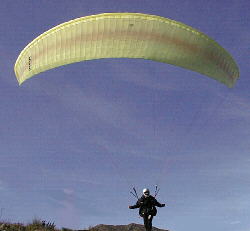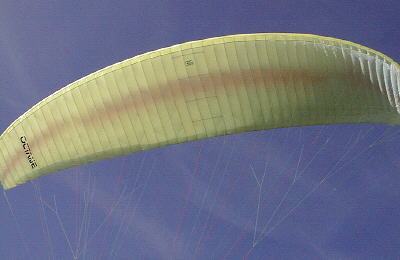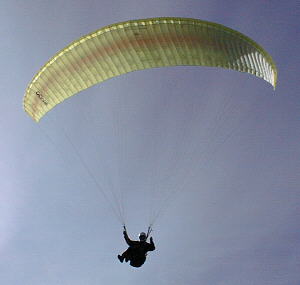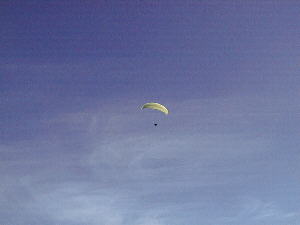|
Thanks to http://www.paragliding.co.za
Is the OZONE Octane "a
sports pilot's dream"?
 "A wing that will take you from your early XC days through to
your wildest adventures, with security," said Ozone's website. "A wing that will take you from your early XC days through to
your wildest adventures, with security," said Ozone's website.
Multiple world champion John Pendry. Multiple world champion Robbie
Whittall. Aerodynamicist Dave Pilkington. And renowned glider designer
Bruce Goldsmith (now returned to Airwave). Put these boys in a room
together, and what kind of glider do you expect them to come up
with? Something breathtaking, ahead of its time.
As the ultimate test, Bob Drury and Rob Whittall took the Octane
in to harsh Himalayan conditions during their recent BBC film expedition.
A wing with such an impressive history of development is hard to
ignore, and even more difficult for a free-flying pilot like myself
to criticise, but I'll do my best to cut through the hype.
CONSTRUCTION :
Following in the footsteps of Apco Aviation, Ozone has opted to
use the tough Gelvinor fabric on their upper surface. Having witnessed
gliders flying well over 400hours in the harsh UV of South Africa,
I can vouch for its track record of durability. The Gelvinor used
on the Octane is not the heavy, siliconised fabric of the past,
but a crinkly, light new weave.
'V-supports' reinforce the glider inside the cells at the line-attachment
points (every second cell), but do not extend along the whole chord,
which keeps the overall weight down.
Tape. There's tape along both sides of the cell-openings, tape
along the trailing edge, and wider tape inside the wing, reinforcing
spanwise a cross the A, B, C and D hang-points (in the centre of
the wing only). This solid build is echoed in the risers - simple,
clean black webbing, neat colour-coding, standard triangular maillons,
rubber keepers. A thick loop at the final hang-point shows good
finish. 
The speed system uses two sturdy pulleys to engage a very traditional
adjustment to the risers, maintaining an equal progression. The
D's remain fixed, A's go down by 17cm, and the B's and C's float
to keep the change linear. The brake-toggl es are soft, filled with
a spongy fabric which is a pleasure on the back of the hands ( for
those who fly with the loops over the wrists ). Thanks, guys!
Apart from inserting luminous repositories for night-flying, I
couldn't find much use for "the butt- hole", a slit on
the trailing edge at the wingtip (sealed with velcro). But some
pilots will love it for dumping their load of sand, grit and unnamed
creatures which creep into the wingtips.
LAUNCH :
Slow, even pullup. Sits nicely overhead, if anything slightly forewards
of vertical, which makes the launch-run easy. It wants to fly, and
needs to be held back a bit on the brakes.
HANDLING :
The Octane feels like an intermediate, with moderate energy retention
in turns. The brake pressure is light and smooth. It's easy to turn
even without weightshift. She is sensitive to weightshift, reminiscent
of the Firebird Flame, but does not bank too far. It feels as if
you are driving along a road which is raised in the middle - lean
slightly to the right, and the wing moves across and banks the perfect
amount for a thermalling turn. I flew in some grotty Fohn conditions,
and could put the Octane on its wingtip and wang up inside the narrow
cores. Some outside brake is needed to keep the turn optimised,
though the tips remain well pressurised even with no brakes applied.
This wing showcases Ozone's solid research and testing - the Octane
has measured, balanced handling yet retains a certain flying finesse.
GLIDE :
Yeeha! The Octane does everything it's Serial Class predecessor
did, but its safer. On trim the glide is identical to the Ozone
Proton, with the Proton maybe 0.5km/h faster. On full speedbar it
held an identical glide and speed to the Proton over 2 minutes (against
an equal weighted pilot, both on Mediums). And the glide at full
speed is good - I could use the bar all the way to pass other pilots
on a crossing without losing much on altitude.
 SECURITY : SECURITY :
The response to spins, stalls and asymmetric tucks puts the glider
firmly in the DHV2 class - 'lively' but safe. The reinflation from
smaller-than-50% collapses is spontaneous and positive, with the
wing banging out before even 60 degrees of turn. With the bigger
asymmetrics, I found the wing diving to the horizon and turning
through 90 degrees before the decelerating phase and reinflation.
But a competent pilot would be able to catch and countersteer the
collapse easily, and it reinflates before 180 degrees.
The front tuck had a delayed opening, passing through a short stall
phase before flying with a very mild surge.
I flew the wing in grotty Fohn conditions, and was thrown around
by turbulence, though only had a few mild tip closures. With a little
pilot input, the Octane can be held steady. On full speedbar the
feedback from the wing increases, so you'll know when to step off
the bar to avoid major deflations. Landings are easy. The wing can
be slowed very effectively with the butterfly technique, useful
for zero-and downwind landings. I really needed this when slope-landing
at an accident scene during the review, on a steep, rock-strewn
mountain-side. The Octane set me down neatly, with predictable,
precise handling.
SUMMARY :
The Octane is the recommended fuel for the enthusiastic xc pilot
wanting a wing with responsive, light handling, great performance
and the ability to crank really tight turns in narrow cores. It
has a 'light' feel in the air, providing good feedback via the harness,
yet it retains a secure aerofoil. Glides are smooth and fast, but
if you want to stop to work a sudden thermal, the Octane's reaction
is quick. It is best suited to pilot's who enjoy and display finesse
in their flying.
 If you're unsure of which class you should be interested
in, read my article
on upgrading. If you're unsure of which class you should be interested
in, read my article
on upgrading.
THANKS TO :
Mike Kinsey (SA distributor for Ozone) for the use of the Octane.
Phil Bristow for flying alongside. Ozone team for their dedication
to detail, and the thorough research evident in their latest release.
TECHNICAL SPECIFICATIONS :
OZONE PARAGLIDERS - www.ozone-gliders.com
South Africa - Mike Kinsey - mikep@icon.co.za
| OCTANE ( DHV2 ) |
|
Medium |
|
| Number of cells |
|
53 |
|
| Projected area (m2) |
|
23.35 |
|
| Flat Area (m2) |
|
26.89 |
|
| Projected span (m) |
|
9.55 |
|
| Flat span (m) |
|
11.78 |
|
| Projected Aspect Ratio |
|
3.91 |
|
| Flat Aspect Ratio |
|
5.16 |
|
| Root Chord (m) |
|
2.85 |
|
| In-flight weight range (kg) |
|
80-100 |
|
| Max speed (km/h) |
|
50 |
|
| |
|
|
|
| Airborne reviewer
(kg) |
|
100 |
|
| Vmin in review (km/h) |
|
23 |
|
| Vtrim in review (km/h) |
|
37 |
|
| Vmax in review (km/h) |
|
50 |
|
| |
|
|
|
| Altitude of review
(m above sea) |
|
800 |
|
| Air pressure Qnh (in
hPa) |
|
1019 |
|
| Air temperature (degrees
C) |
|
17 |
|
| Correction factor*
for speeds |
|
101% |
|
* Note : Apply the correction factor to scale the results to a
standardised condition of 1000m altitude, 1013.2 hPa Qnh pressure,
and 15 deg.C. air.
|
 "A wing that will take you from your early XC days through to
your wildest adventures, with security," said Ozone's website.
"A wing that will take you from your early XC days through to
your wildest adventures, with security," said Ozone's website.

 SECURITY :
SECURITY : If you're unsure of which class you should be interested
in, read my
If you're unsure of which class you should be interested
in, read my